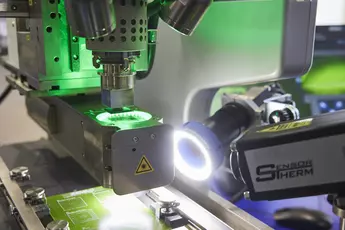Sensors in electronics manufacturing
October 11, 2023
- Billion-dollar market for industrial sensors through digitalization
- Sensor technology in almost all manufacturing processes
- Smart manufacturing sensor technology live at productronica
Sensors are the key technology used by smart systems in a connected world. As the leading data supplier, they produce the raw material used in digitalization systems throughout the entire value chain in virtually all industrial segments. Leading players in this highly innovative growth industry will shed light on current trends and technologies at productronica from November 14 to 17, 2023. Conceptual sponsor of the most important event for the industry is the VDMA Productronics Department.
The age of networked and intelligent manufacturing started long ago. Flexible, automated production systems are enabling the effective production of even the smallest batch sizes for the first time. The decisive role of the data supplier is played by the industrial sensors. They track all machine operation processes, collect information and detect even the smallest deviations from normal operation.
The market potential of industrial sensor technology is largely determined by the megatrends of IIoT, Industry 4.0 and automation. Analysts from Market Research Future (MRFR) estimate the global market to be worth $46 billion by 2032, with a compound annual growth rate (CAGR) of 7.5 percent from 2023. The biggest growth will be in image sensors.
Heterogeneous industrial sensor market
Sensors ensure consistently high product quality and transparency as part of quality control. Automated image processing (machine vision) with industrial cameras, digital sensors, special optics and software, and increasingly also with deep learning, is an important component here.
Predictive maintenance—currently one of the most successful Industry 4.0 scenarios—relies mainly on sensors for vibration, temperature, pressure, gas, humidity or sound. They provide the data for autonomous learning prediction models that calculate optimized maintenance intervals or proactively initiate the replacement of impaired components.
On customer machines and systems, these sensors open up new data-based business models in the form of innovative billing mechanisms such as pay-per-use, product-as-a-service (PaaS), machine-as-a-service (MaaS), or service offerings such as predictive maintenance.
Cost-effective sensors for industry
The sensor technology does not always have to meet expensive industrial standards. Data fusion of less powerful sensors is equally capable of performing a wide variety of tasks. Also simple acoustic sensors with corresponding frequency analysis, for example, are often sufficient to determine material wear and thus the maintenance condition.
In addition, advances in MEMS (micro-electronic mechanical systems) technology means that ultra-small, low-cost and energy-efficient MEMS sensors can replace conventional industrial sensors. These include accelerometers, gyroscopes, inertial measurement units (IMU) and magnetometers, as well as temperature and pressure sensors for environmental monitoring. In combination with microcontrollers and communication interfaces, they form intelligent solutions for monitoring everything from machines to entire industrial plants.
The future of sensors
For Industry 4.0 and the next human- and environment-centric Industry 5.0, sensor technology remains a key technology.
Increasingly smaller and more compact sensors are expected to cover a wider range of devices and applications, and high-tech materials such as graphene and nanocomposites, as well as quantum mechanical concepts, are expected to increase sensitivity and robustness.
In addition, the development of smart industrial sensors in particular has been making progress in recent years. When networked and equipped with intelligent data processing, they turn into powerful tools for monitoring and controlling industrial processes. Increased integration with cloud computing, big data or edge computing will provide even more comprehensive and precise insights in the future.
Smart material flow live!
The Smart Reordering System from Balluff, for example, allows connection to an ERP system.
The VDMA co-exhibitor will present a solution for inventory reduction, digitalization of replenishment processes and optimization of material flows in Hall B2, Booth 448. Filling quantities are monitored by battery-powered and radio-networked sensors, critical stocks are reported and the replenishment process is triggered without manual effort.
The exhibit shows how the Smart Reordering System of the global sensor and automation specialist can fully automate material supply with the help of the Smart Reordering System.
Industrial sensors at productronica
In cooperation with the Productronics Department of the VDMA—the conceptual and technical sponsor of productronica—lectures and live demonstrations in Hall B2 Stand 448 will cover the topic of sensors.
Automation, robotics and the future of measuring and testing technology are the topics of the productronica Forum in Hall A1.
In the Semiconductors Cluster and Future Production Cluster, the productronica exhibitors will show their latest innovations in these areas.
With SEMICON Europa, which is once again taking place alongside productronica, the world’s leading trade fair for development and manufacturing is expanding its offering in the semiconductor manufacturing industry.

- PR Manager

